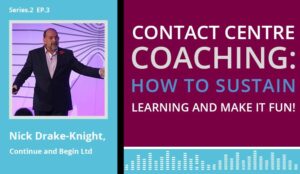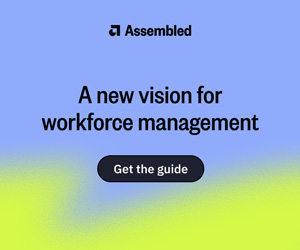Senior managers in any call centre will agree that across their organisation there exist pockets of performance excellence, vast fields of mediocrity, and occasional pits of despair.
Soft-skills training is like ‘wet mud thrown against the wall; most slides off immediately’.
So how can we make coaching work effectively? Nick Drake-Knight outlines a methodology to get coaching to stick.
COACHING
Coaching is a hot topic in call centre management.
But what is coaching? Isn’t it the same as training? Or mentoring? Or is it a bit like counselling? Let us be clear on this:
Coaching is a process designed to help people identify their own chosen path in relation to a work skill or discipline. It is about asking.
When work-based coaching is consistently done well and has become a part of the culture of a call centre, it encourages self-learning, invites creativity and delivers higher performance. It becomes OK for call centre staff to ‘admit’ to areas in which they need personal development, new skills, or new ways of doing things – when otherwise they might have hidden their uncertainty, or covered up their inadequacies.
When coaching is fully integrated into a call centre, it builds confidence and generates ‘response-ability’ in individuals; that is, the ability to respond – to take action to improve their ability to perform at work. Ownership by the coachee and self-determination are key facets of effective coaching.
The challenge for many call centres is to find sufficient time for effective coaching.
“CONTINUE & BEGIN” FAST COACHING
There are plenty of good coaching models in call centres today, but few of them have simplicity and rigour combined with speed of application and, critically, a ‘feel-good factor’.
A specific type of coaching, which I call “Continue & Begin Fast Coaching” can be delivered as an everyday part of a call centre team leader’s job function.
The model is simple in structure, easy to use, and low risk. It requires nothing in the way of ‘personal analysis’. It is therefore safe to use, even in the clumsiest of hands.
The “Continue & Begin” model recognises that a coachee is already exhibiting excellence in a number of areas of customer service and celebrates this by formally recording the behaviours the coachee wishes to continue to deliver well.
Sometimes it takes a while for coachees to identify what they have done well. Some national cultures (British is a good example) tend to inhibit our willingness to tell others what we believe we excel at.
A typical Continue & Begin coaching action plan is described below:
|
CONTINUE & BEGIN Action Plan |
|
| Team Member | Penny Chilton |
| Coach | Sally Phillips |
| Date | 4th March |
| Personal Strategies | Continue to:
1. Maintain upbeat tempo of introductory message 2. Use Clean Language as a rapport builder 3. Keep AHT at level ‘X’ 4. Follow key script process5. Wrap within ‘Y time’ Begin to: 1. Use Positive Frame sign-off on every occasion 2. Explain benefits of linked services, as well as their features Internal Support: Meet with Jackie each Thursday 9am to follow up on this plan |
|
Commitment is doing the thing you said you would do, long after the mood you said it in has left you!
|
Once a set of Continue To behaviours has been recorded, the coachee is now in a psychological position where their ego is strong enough to consider the areas of operation in which they could be even better.
Notice the positive construct of the language pattern ‘could be even better’.
There is no suggestion that the coachee is in any way deficient or inadequate.
On the contrary, the language pattern hints at the coachee already being competent and that this is an opportunity to take that competence to an even higher level. The power of this method is that at no stage is the coachee confronted with direct criticism from the coach.
The strategy for identifying areas in which coachees could begin to do even better is simply to ask them what they think.
In the case of a recorded call or telephone mystery shop evaluation this is a simple task, as the coachee usually blurts out their perceived inadequacies at the start of the meeting, after an audio file has been played back.
For many call centre staff, having heard themselves on audio file, self-criticism begins in earnest. Team members beat themselves up over the apparently ‘dreadful’ performance they have just heard themselves deliver.
Let’s explore how this works in practice. After the recorded call has been listened to, a typical Continue & Begin discussion will go something like this:
Coach: Well, what do you think?
Coachee: It was awful; I can’t believe I sounded like that. I sounded so miserable. The customer must have thought I was rude. And I didn’t up-sell when I could have done. It was terrible!
Coach: I’m sure there are a few things you might want to do differently next time. Let’s park those (over here) for a moment. What were you really pleased about?
Coachee: What do you mean?
Coach: What did you hear that made you think, “Yes, I did well with that; I’m pleased with that”?
Coachee: Nothing.
Coach: Nothing? Nothing at all?
Coachee: Not really.
Coach: There must be something you thought you did well.
Coachee: I suppose I used the customer’s name quite early on.
Coach: Yes, you did – I noticed that, very prompt. What else did you do well?
Coachee: I checked the account number.
Coach: That’s right, you did. What else?
Coachee: I asked him a couple of questions about his enquiry. I found out what he didn’t want, too, because he told me. And I asked him if there was anything else I could help him with. I sometimes forget that.
Coach: They were excellent questions. And yes, you did ask him if there was anything else you could do for him. What else?
Coachee: That’s about it, I think. Oh, I got all his details so we can send him the newsletter when it comes out.
Coach: Ok, yes, you did do that. Let’s just summarise what you did well: there was… well, can you remember?
Coachee: I think so. I used his name, I checked the account number, I asked some good probing questions, and found out what he didn’t want, I asked him if there was anything else, and I got his details – oh, nearly forgot – I introduced myself by name!
Coach: You did. Well done. Pretty impressive when you think it through, isn’t it?
Coachee: Yes, I suppose so.
Coach: I guess you would like to Continue To do those things well, wouldn’t you?
Coachee: Well, yes, of course.
Coach: OK, let’s write them down then on this action plan. The things you want to Continue To do well, each time you take a call. Here’s a pen.
Coachee: OK.
Coach: Now, there were a couple of things that you said you wanted to do differently next time. Remind me, what were they? I think we parked them over here…
Coachee: Oh, those… yes, well they were…
And only then do we begin the process of discussing the things the coachee would like to Begin To do differently.
As a general rule, it is best to find a 2:1 ratio, where the coachee is encouraged to identify twice as many Continue To behaviours as Begin To behaviours.
The temptation for the coach and the coachee is to go straight for the improvement strategies and address lots of Begin To behaviours immediately! This is an ineffective strategy. It’s much better to identify just a small number of Begin To behaviours, never more than three, and to take action on these three so that they quickly become areas of competence.
It is now time to move on to the final part of the coaching session, before the coachee goes back to their work station to ‘make it happen’. At this point a good Continue & Begin fast coach will seek explicit commitment from the coachee, and with direct eye contact ask:
“Are you absolutely committed to these Continue and Begins?”
The response is usually a definite, “Yes! Of course I’m committed to them!” and the coach can then be confident that the coachee will take action rather than talk about taking action.
When Begin To behaviours have been monitored through review sessions, and changes have begun to occur, those Begin To ambitions have a habit of becoming Continue To behaviours.
That is personal development at its best.
Nick Drake-Knight is founder of NDK Group, a customer service and sales process consultancy. Nick regularly speaks at national and international conferences on the subject of sustainability (or lack of it) in communication skills training. For further details, visit ndk-group.com or follow him on www.twitter.com/NDKgroup
Author: Jo Robinson
Published On: 23rd Jan 2013 - Last modified: 14th Aug 2025
Read more about - Skills, Skill Development, Training and Coaching






































Completely lost me on this.
A little cheesy
This approach definitely works, I have seen lot’s of successful coaches using these techniques, maybe using different language but still motivational awareness first before developmental/formative. Catch them doing things right, praise them, raise their awareness ad then support them do be even more successful!
I agree with C Nunn. The critical success factor in changing behaviours through coaching, is that the coachee has to be totally bought in to conciously making that change, and this technique helps to keep their self-esteem and to motivate them to do it.